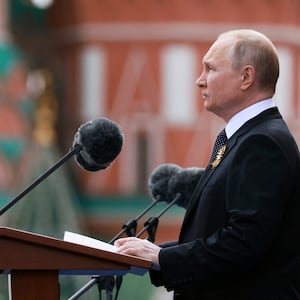A week that began with the world wondering if the U.S. and China were inevitably headed to war over Taiwan took a different turn Thursday thanks to a speech delivered by Secretary of State Antony Blinken at George Washington University in Washington, D.C.
The concerns about looming conflict came on Monday when President Biden indicated that the U.S. would use military force to protect Taiwan from a potential Chinese attack. While Biden and his team quickly sought to clarify that the U.S. was not backing away from its policy of “strategic ambiguity” regarding Taiwan—arguing that what the president meant was that he was merely reiterating a long-standing commitment “to provide Taiwan with the military means to defend itself”—his remarks triggered a tough response from the Chinese, who asserted China maintained “the strong resolve, determination, and capability” to defend its “national sovereignty and territorial integrity.”
As a consequence, interest was high in Blinken’s remarks. And while the secretary of state did reiterate that U.S. policy had not changed, that the administration remains committed “to our ‘one China’ policy,” and that the “we continue to have an abiding interest in peace and stability across the Taiwan strait,” neither Taiwan nor looming conflict was the focus of Blinken’s speech. That said, it was a speech that exploded certain nuggets of conventional wisdom about the U.S.-China relationship, drew some of its sharpest battle lines with domestic political opponents, and, most important, framed the U.S.-China relationship in a manner very different from the rivalries that have been at the center of U.S. foreign policy during the past century.
ADVERTISEMENT
From the outset, Blinken not only defused the week’s speculation about rapidly escalating tensions but he also confronted head on one of the dominant themes of conversations about the future of the U.S.-China relationship. Early in his 40 minutes of remarks that were themselves a summary of a classified U.S.-China strategy that the administration had adopted months earlier, he said, “We are not looking for conflict or a new Cold War. To the contrary, we’re determined to avoid both.”
That is not to say the speech was particularly conciliatory or that it papered over the differences that are clearly central to the world’s most important bilateral relationship. Rather, it sought to strike a tone that was realistic, forward-looking, and reflective of the unique nature of the relationship, one that sees the two powers seeking to influence the world in divergent directions and yet also acknowledges their interdependence and shared interests.
In fact, Blinken framed the China remarks in a way that underscored emphatically that there are no foreign policy issues of greater importance for this administration. He did this by invoking the menace of Russian President Vladimir Putin, whom Blinken called “a clear and present threat,” and of the unified response to Russia’s aggression. He noted that “while the war is not over, President Putin has failed to achieve a single one of his strategic aims.” And then he said, “Even as President Putin’s war continues, we will remain focused on the most serious long-term challenge to the international order—and that’s posed by the People’s Republic of China.”
“China,” he then said, “is the only country with both the intent to reshape the international order and, increasingly, the economic, diplomatic, military and technological power to do it.” The crux of his objection to China’s growing influence, he said, was that “Beijing’s vision would move us away from the universal values that have sustained so much of the world’s progress over the past 75 years.”
The remarks, however, did not then turn to the language of the Cold War or, as those with memories of the Cold War with the Soviet Union might have expected, toward the ideas that defined that much more zero-sum struggle with an adversary. There was no talk of ideas like defeating the Chinese, no description of them as enemies, no discussion of containment. Instead, the speech included praise for China’s progress and the factors that led to it, like “the talent, the ingenuity, and the hard work of the Chinese people.” Blinken underscored early on that the U.S. did not seek to “block China from its role as a major power, nor stop China… from growing their economy or advancing the interests of their people.” Later in the speech he also noted that while the U.S. has “profound differences with the Chinese Communist Party and the Chinese government… those differences are between governments and systems—not between our people.” He spoke of “great respect for the Chinese people… their achievements, their history, their culture.” And later he condemned attacks in the U.S. on people of Chinese or Asian heritage.
That said, Blinken observed that China was perhaps the greatest single beneficiary of “the stability and opportunity that the international order provides” but that “rather than using its power to reinforce and revitalize the laws, the agreements, the principles, the institutions that enabled its success so that other countries can benefit from them, too, Beijing is undermining them. Under President Xi, the ruling Chinese Communist Party has become more repressive at home and more aggressive abroad.”
Here he underscored an evolution in U.S. thinking over the past several decades. During the Clinton administration, in which I served, there was a view that welcoming China into the international community would help change China and promote positive reforms. In the words of one senior Biden administration official, “that view was hopelessly naïve.” In the eyes of this administration, after years of Chinese reform that had created the optimism with which the Clinton-era view was based, the arrival of Xi heralded a change, one that led toward repression and an active desire in Beijing to promote an alternative view of how the world should work.
Blinken’s speech enumerated ways—from violating international norms of trade to human rights violations in Xinjiang Province to their partnership with the Russians and support for Russia’s violation of Ukrainian sovereignty—the Chinese have demonstrated that they are actually actively undermining standards and goals established by the global community over the past three-quarters of a century.
The strategy outlined by the secretary of state in response to that trend but reflecting the complex nature of a relationship with a rival whose economy has attracted operations of 70,000 U.S. companies and who plays a vital role in managing global issues from climate to battling pandemics, is at its core one of strategic competition.
Blinken’s message to China boiled down to its Biden-esque core was essentially: “You want to compete with us? Bring it on!”
There were three themes to the speech: invest, align, and compete. Blinken described how we would “invest in the foundations of strength at home,” “align our efforts with our network of allies and partners,” and “compete with China to defend our interests and build our vision for the future.”
In attendance at the speech was Sen. Mitt Romney (R-UT) one of the authors of the U.S. Innovation and Competition Act (USICA), bipartisan legislation cited by Secretary Blinken to better enable the U.S. to compete with China.
The act, Blinken asserted, would help restore U.S. R&D leadership and lead to “historic investments in research and innovation, including in fields like artificial intelligence, biotechnology, quantum computing.” He then called for action, noting, “The House and Senate have passed bills to support this agenda, including billions to produce semiconductors here and to strengthen other critical supply chains. Now we need Congress to send the legislation to the president for his signature.”
One of the “core source(s) of national strength that we’ll be relying on in this decisive decade” would be, according to Blinken “our democracy.” He observed that the process is sometimes messy and that “We are not perfect” but that in the end our system is our ticket to becoming a “more perfect union.”
Blinken, when speaking about closer coordination with friends and allies, cited the recent spate of administration actions with an Indo-Pacific focus, from the ASEAN Summit in Washington to meetings during Biden’s recent trip that touched upon core alliances like those with Japan and Korea, with the Quad (India, Japan, Australia and the U.S.), AUKUS (Australia, the U.K., and the U.S.), and the countries coming together to form the Indo-Pacific Economic Framework for Prosperity. Calling the agreement “a first-of-its-kind initiative for the region,” he said it “renews American economic leadership but adapts it for the 21st century by addressing cutting-edge issues like the digital economy, supply chains, clean energy, infrastructure, and corruption. A dozen countries, including India, have already joined.”
U.S. domestic observers of the speech would have a hard time ignoring the number of points, like those cited above, that were not terribly subtle shots at the policies and politics of the Donald Trump-led Republican Party. From the emphasis on an active competitiveness policy to citing Trump rival Romney, from the focus on a democratic system Trump actively sought to undermine (and downplay in his administration’s foreign policy) to promoting new alliances and an international order Trump sought to undo, from the condemnation of anti-Chinese racism to the nuanced approach to the China relationship itself, this speech consistently sent the message that the U.S. was embracing a new approach to foreign policy.
The competition section of the speech ranged from a discussion of unfair trade practices to a commitment to opposing “Beijing’s aggressive and unlawful activities in the South China Sea,” as well as a strong statement of support for Taiwan. The measures to be taken to defend our interests were enumerated in detail but summed up in a way that reiterated the core initial point:
"Competition need not lead to conflict. We do not seek it. We will work to avoid it. But we will defend our interests against any threat. To that end, President Biden has instructed the Department of Defense to hold China as its pacing challenge, to ensure that our military stays ahead. We’ll seek to preserve peace through a new approach that we call 'integrated deterrence'—bringing in allies and partners; working across the conventional, the nuclear, space, and informational domains; drawing on our reinforcing strengths in economics, in technology, and in diplomacy."
Blinken also noted that in areas where cooperation with China was possible or, in certain cases, essential, from climate to pandemics, the U.S. would actively pursue working together with Beijing.
In conclusion, because China is such a high priority, Blinken noted that the State Department would be building an internal “China House,” an effort to devote expanded resources to addressing the broad range of challenges and objectives outlined in the speech.
In March 2021, Blinken delivered a speech outlining the core pillars of his foreign policy agenda. It defined the U.S.-China relationship as “the biggest geopolitical test of the 21st century.” He stated that “Our relationship with China will be competitive when it should be, collaborative when it can be, and adversarial when it must be.”
Blinken’s latest speech, which will go alongside that as one of the defining policy statements of the Biden era, suggests that while all three approaches will be employed, the emphasis is clearly shifting to a focus not just on competing with China but on winning that competition.









